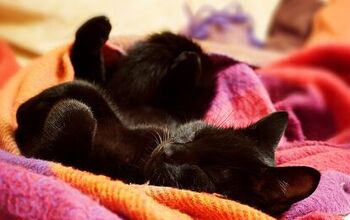Do Cats Dream of Chasing Mice and Balls of Yarn?

You’re already well aware of the many types of dreams that your mind can conjure up when you’re fast asleep, but have you ever wondered: do cats dream?
When watching a cat sleep, you may notice her making sounds or moving her body. She might, for example, start moving her lips and whiskers, flicking her tail, or shaking her paws. But are these merely random movements of the physical body, or do they indicate that something deeper is going on in your kitty’s mind?
So, do cats dream just like humans do? Or do they fall into a dreamless sleep?
Yes, Cats Do Dream
After a kitty falls asleep, she will cycle through the same stages of sleep that humans do. There will be slow wave sleep periods that transition to rapid eye movement (REM) sleep, and it is during REM that most dreaming takes place.
Related: Why Do Cats Sleep So Much?
The Research into Feline Sleep
Studies into whether or not cats dream date back to the 1960s, when scientists wanted to figure out what was going on in the mind of a sleeping animal. Medical reports were describing people who were moving during REM sleep, when the muscles are usually paralyzed to prevent such movements.
French scientists J F Delorme and Michel Jouvet removed the pons from a feline’s brainstem in 1965. This is the part of the brain that would normally cause the muscles to become paralyzed during REM, so the dream state without the pons was referred to as REM-A. By removing the pons, sleeping cats would actually act out their dreams by behaving aggressively and walking around.
As a result, they concluded that the animals were having dreams of their activities during waking hours. And they were right because, since then, more research has proven this. For example, Adrian Morrison, a veterinary neurologist, found that pets in REM-A would move their heads and even act out predatory behaviors, as if they were dreaming of following a toy or chasing down birds.
Related: Why Do Cats Meow at Night?
MIT scientists Matthew Wilson and Kenway Louise were able to record the activity of neurons within the hippocampus of rats by using electrodes in 2007. This part of the brain is associated with forming and encoding memories, and it’s the same in rats as it is in cats.
First, the researchers recorded the activity of rats’ brain cells while they were awake and running through mazes. Then they observed the same neurons while the animals slept. They found that there were identical firing patterns. In other words, the rats would dream of running through the maze just like they did while they were awake.
What Dreams May Come?
Researchers and scientists who study cats’ sleep patterns have found that felines likely dream about their typical day-to-day activities. So your cat may dream about chasing down prey, playing with her favorite toy, or snuggling with you. And, just like people, cats can also have unusual dreams and nightmares.
Kittens Dream More Than Adult Cats
Sleep is an opportunity for the body to relax and repair itself, and it also gives the mind a chance to process experiences and lessons that were gained during waking hours. This is why younger animals will spend a greater amount of time in a dream-filled sleep compared to older cats. Kittens aren’t only growing every day, but they’re also learning a lot of new things and processing a lot of new information that could result in a variety of dreams.
Now that you know that your cat dreams when she falls into a deep sleep, you have an explanation for her sometimes strange movements while she naps the day away. It’s just another example of the fact that humans and animals are more alike than people realize.

Lisa Selvaggio is a freelance writer and editor, and our resident cats-pert, with certifications in pet nutrition and pet first aid. She enjoys producing content that helps people understand animals better so they can give their pets a safe and happy home.
More by Lisa Selvaggio























